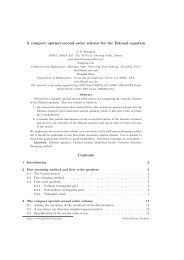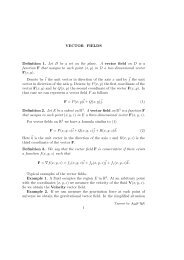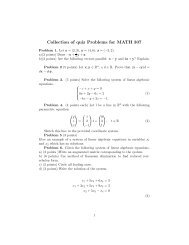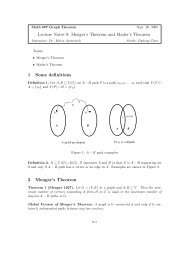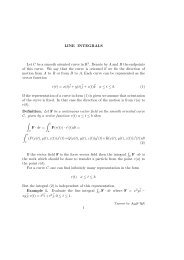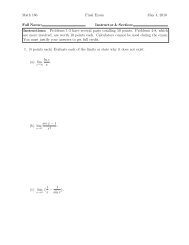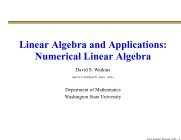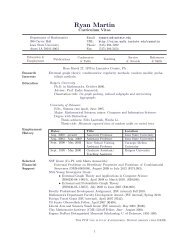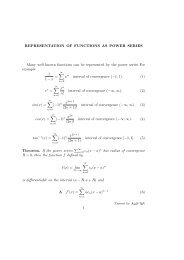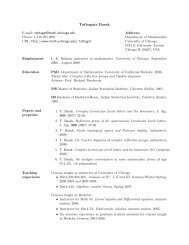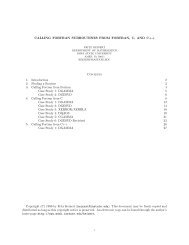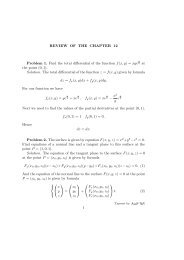Matrix Completion Problems - Index of - Iowa State University
Matrix Completion Problems - Index of - Iowa State University
Matrix Completion Problems - Index of - Iowa State University
You also want an ePaper? Increase the reach of your titles
YUMPU automatically turns print PDFs into web optimized ePapers that Google loves.
Introduction to <strong>Matrix</strong> <strong>Completion</strong> <strong>Problems</strong><br />
The (Strictly) Copositive <strong>Matrix</strong> <strong>Completion</strong> <strong>Problems</strong><br />
References<br />
<strong>Matrix</strong> <strong>Completion</strong> <strong>Problems</strong><br />
Leslie Hogben<br />
<strong>Iowa</strong> <strong>State</strong> <strong>University</strong><br />
October 23, 2005<br />
AMS Central Section Meeting<br />
Lincoln, NE
Introduction to <strong>Matrix</strong> <strong>Completion</strong> <strong>Problems</strong><br />
The (Strictly) Copositive <strong>Matrix</strong> <strong>Completion</strong> <strong>Problems</strong><br />
References<br />
Introduction to <strong>Matrix</strong> <strong>Completion</strong> <strong>Problems</strong><br />
Partial matrices<br />
Classes <strong>of</strong> Matrices<br />
Graph Theoretic Techniques<br />
The (Strictly) Copositive <strong>Matrix</strong> <strong>Completion</strong> <strong>Problems</strong><br />
Specified Diagonal<br />
Unpecified Diagonal<br />
References
Introduction to <strong>Matrix</strong> <strong>Completion</strong> <strong>Problems</strong><br />
The (Strictly) Copositive <strong>Matrix</strong> <strong>Completion</strong> <strong>Problems</strong><br />
References<br />
Partial matrices<br />
Classes <strong>of</strong> Matrices<br />
Graph Theoretic Techniques<br />
Partial Matrices<br />
- A partial matrix is a square array in which some entries are<br />
specified and others are not.<br />
- A completion <strong>of</strong> a partial matrix is a choice <strong>of</strong> values for the<br />
unspecified entries.<br />
Example:<br />
B =<br />
⎡<br />
⎢<br />
⎣<br />
2 −1 0<br />
−1 2 2 <br />
2 3 1<br />
0 1 1<br />
⎤<br />
⎥<br />
⎦<br />
⎡<br />
A = ⎢<br />
⎣<br />
2 −1 0 0<br />
−1 2 2 1<br />
0 2 3 1<br />
0 1 1 1<br />
⎤<br />
⎥<br />
⎦<br />
B is a partial matrix and A is a completion <strong>of</strong> B.
Introduction to <strong>Matrix</strong> <strong>Completion</strong> <strong>Problems</strong><br />
The (Strictly) Copositive <strong>Matrix</strong> <strong>Completion</strong> <strong>Problems</strong><br />
References<br />
Partial matrices<br />
Classes <strong>of</strong> Matrices<br />
Graph Theoretic Techniques<br />
<strong>Completion</strong>s<br />
- A matrix completion problem asks whether a partial matrix<br />
(or family <strong>of</strong> partial matrices with a given pattern <strong>of</strong> specified<br />
entries) has a completion <strong>of</strong> a specific type, such as a positive<br />
definite matrix.<br />
Example:<br />
B =<br />
⎡<br />
⎢<br />
⎣<br />
2 −1 0<br />
−1 2 2 <br />
2 3 1<br />
0 1 1<br />
⎤<br />
⎥<br />
⎦<br />
⎡<br />
A = ⎢<br />
⎣<br />
2 −1 0 0<br />
−1 2 2 1<br />
0 2 3 1<br />
0 1 1 1<br />
⎤<br />
⎥<br />
⎦<br />
<strong>Matrix</strong> A completes B to a positive semidefinite matrix.
Introduction to <strong>Matrix</strong> <strong>Completion</strong> <strong>Problems</strong><br />
The (Strictly) Copositive <strong>Matrix</strong> <strong>Completion</strong> <strong>Problems</strong><br />
References<br />
Partial matrices<br />
Classes <strong>of</strong> Matrices<br />
Graph Theoretic Techniques<br />
Submatrices<br />
- The submatrix A[α, β] consists <strong>of</strong> the entries in rows in α and<br />
columns in β.<br />
- The submatrix A[α] := A[α, α] is principal.<br />
Example:<br />
A =<br />
⎡<br />
⎢<br />
⎣<br />
2 −1 0 0<br />
−1 2 2 1<br />
0 2 3 1<br />
0 1 1 1<br />
⎤<br />
A[{1, 3}, {2, 3, 4}] =<br />
⎥<br />
⎦ A[{1, 3}] = [ 2 0<br />
0 3<br />
[ −1 0 0<br />
2 3 1<br />
]<br />
]
Introduction to <strong>Matrix</strong> <strong>Completion</strong> <strong>Problems</strong><br />
The (Strictly) Copositive <strong>Matrix</strong> <strong>Completion</strong> <strong>Problems</strong><br />
References<br />
Partial matrices<br />
Classes <strong>of</strong> Matrices<br />
Graph Theoretic Techniques<br />
Partial X -<strong>Matrix</strong><br />
- All classes X <strong>of</strong> matrices discussed are hereditary, i.e. if A is<br />
an X -matrix then every principal submatrix <strong>of</strong> A is an<br />
X -matrix.<br />
- If X is hereditary, in order for a partial matrix B to have an<br />
X -completion, it is necessary that every fully specified<br />
principal submatrix <strong>of</strong> B is an X -matrix, and any sign<br />
conditions on the entries are satisfied.<br />
- These conditions are not usually sufficient to guarantee an<br />
X -completion.<br />
- A partial matrix B is a partial X -matrix if every fully specified<br />
(principal) submatrix <strong>of</strong> B is an X -matrix, and any sign<br />
conditions on the entries are satisfied.
Introduction to <strong>Matrix</strong> <strong>Completion</strong> <strong>Problems</strong><br />
The (Strictly) Copositive <strong>Matrix</strong> <strong>Completion</strong> <strong>Problems</strong><br />
References<br />
Partial matrices<br />
Classes <strong>of</strong> Matrices<br />
Graph Theoretic Techniques<br />
- All matrices discussed are real and square.<br />
- All classes <strong>of</strong> matrices discussed are generalizations <strong>of</strong> the<br />
positive definite matrices.<br />
- The following are equivalent:<br />
- A is symmetric and for all x ∈ R n , x ≠ 0, x T Ax > 0 (positive<br />
definite).<br />
- A is symmetric and all eigenvalues are positive.<br />
- A is symmetric and all principal minors are positive.<br />
- Analogous definition/characterizations for positive semidefinite
Introduction to <strong>Matrix</strong> <strong>Completion</strong> <strong>Problems</strong><br />
The (Strictly) Copositive <strong>Matrix</strong> <strong>Completion</strong> <strong>Problems</strong><br />
References<br />
Partial matrices<br />
Classes <strong>of</strong> Matrices<br />
Graph Theoretic Techniques<br />
Classes <strong>of</strong> matrices to be discussed:<br />
- positive definite matrices<br />
- positive semidefinite matrices<br />
- strictly copositive matrices: A is strictly copositive if A is<br />
symmetric and for all x ≥ 0, x ≠ 0, x T Ax > 0<br />
- copositive matrices: A is copositive if A is symmetric and for<br />
all x ≥ 0, x T Ax ≥ 0<br />
Example:<br />
⎡<br />
A = ⎣<br />
2 1 3<br />
1 1 2<br />
3 2 2<br />
is strictly copositive but not positive definite (any positive matrix is<br />
strictly copositive).<br />
⎤<br />
⎦
Introduction to <strong>Matrix</strong> <strong>Completion</strong> <strong>Problems</strong><br />
The (Strictly) Copositive <strong>Matrix</strong> <strong>Completion</strong> <strong>Problems</strong><br />
References<br />
Partial matrices<br />
Classes <strong>of</strong> Matrices<br />
Graph Theoretic Techniques<br />
Classes <strong>of</strong> matrices to be discussed:<br />
- A is a P-matrix if all principal minors are positive.<br />
- A is a P 0 -matrix if all principal minors are nonnegative.<br />
- A is a P 0,1 -matrix if all principal minors are nonnegative and<br />
all diagonal elements are positive.<br />
- And various sign conditions on entries.<br />
Example:<br />
det A = 14,<br />
⎡<br />
A = ⎣<br />
5 1 −1<br />
0 1 2<br />
3 1 3<br />
⎤<br />
det A[{1, 2}] = det<br />
⎦ is a P matrix.<br />
[ 5 1<br />
0 1<br />
]<br />
= 5, etc.
Introduction to <strong>Matrix</strong> <strong>Completion</strong> <strong>Problems</strong><br />
The (Strictly) Copositive <strong>Matrix</strong> <strong>Completion</strong> <strong>Problems</strong><br />
References<br />
Partial matrices<br />
Classes <strong>of</strong> Matrices<br />
Graph Theoretic Techniques<br />
Classes <strong>of</strong> matrices to be discussed:<br />
- A is totally positive if all minors are positive.<br />
- A is totally nonnegative if all minors are nonnegative.<br />
Example:<br />
⎡<br />
A = ⎣<br />
det A = 16,<br />
5 1 0<br />
2 2 2<br />
1 1 3<br />
⎤<br />
⎦ is totally nonnegative.<br />
[ 5 1<br />
det A[{1, 2}] = det<br />
2 2<br />
[ 5 0<br />
det A[{1, 2}, {1, 3}] = det<br />
2 2<br />
]<br />
= 8<br />
]<br />
= 10, etc.
Introduction to <strong>Matrix</strong> <strong>Completion</strong> <strong>Problems</strong><br />
The (Strictly) Copositive <strong>Matrix</strong> <strong>Completion</strong> <strong>Problems</strong><br />
References<br />
Partial matrices<br />
Classes <strong>of</strong> Matrices<br />
Graph Theoretic Techniques<br />
Graph Theoretic Techniques<br />
- Graphs are used for symmetric matrices; otherwise digraphs<br />
are used.<br />
- Digraphs and graphs can have loops but not multiple edges or<br />
arcs in the same direction.<br />
- The specified entries in partial matrix B are represented by<br />
edges in the graph G(B) or D(B).<br />
Example:<br />
1 2<br />
B =<br />
⎡<br />
⎢<br />
⎣<br />
2 −1 0<br />
−1 2 2 <br />
2 3 1<br />
0 1 1<br />
⎤<br />
⎥<br />
⎦<br />
4<br />
3
Introduction to <strong>Matrix</strong> <strong>Completion</strong> <strong>Problems</strong><br />
The (Strictly) Copositive <strong>Matrix</strong> <strong>Completion</strong> <strong>Problems</strong><br />
References<br />
Partial matrices<br />
Classes <strong>of</strong> Matrices<br />
Graph Theoretic Techniques<br />
Permutation Similarity and Vertex Numbering<br />
- All <strong>of</strong> the classes X <strong>of</strong> matrices discussed except totally<br />
positive and totally nonnegative are closed under permutation<br />
similarity.<br />
- Applying a permutation similarity to a partial matrix B<br />
corresponds to renumbering the vertices <strong>of</strong> the digraph D(B)<br />
- If X is closed under permutation similarity, then unlabeled<br />
digraph diagrams can be used.<br />
- For totally positive (nonnegative) matrices, labeled digraphs<br />
must be used.
Introduction to <strong>Matrix</strong> <strong>Completion</strong> <strong>Problems</strong><br />
The (Strictly) Copositive <strong>Matrix</strong> <strong>Completion</strong> <strong>Problems</strong><br />
References<br />
Partial matrices<br />
Classes <strong>of</strong> Matrices<br />
Graph Theoretic Techniques<br />
- A digraph G has the X -completion property if every partial<br />
X -matrix B such that D(B) = G can be completed to an<br />
X -matrix.<br />
- The problem <strong>of</strong>ten reduces to considering the sub(di)graph<br />
induced by the vertices with loops.<br />
Example: If the X -completion problem reduces to the subdigraph<br />
induced by the looped vertices, the left digraph<br />
has the X -completion property.
Introduction to <strong>Matrix</strong> <strong>Completion</strong> <strong>Problems</strong><br />
The (Strictly) Copositive <strong>Matrix</strong> <strong>Completion</strong> <strong>Problems</strong><br />
References<br />
Partial matrices<br />
Classes <strong>of</strong> Matrices<br />
Graph Theoretic Techniques<br />
Theorem (Grone, Johnson, Sá, Wolkowicz LAA 1984)<br />
- A graph having a loop at every vertex has the positive definite<br />
completion property if and only if it is chordal (any cycle <strong>of</strong><br />
length ≥ 4 has a chord).<br />
- A graph has the positive definite completion property if and<br />
only if the subgraph induced by the vertices with loops has<br />
the positive definite completion property.<br />
Example:<br />
has the positive definite completion property.
Introduction to <strong>Matrix</strong> <strong>Completion</strong> <strong>Problems</strong><br />
The (Strictly) Copositive <strong>Matrix</strong> <strong>Completion</strong> <strong>Problems</strong><br />
References<br />
Partial matrices<br />
Classes <strong>of</strong> Matrices<br />
Graph Theoretic Techniques<br />
Graph terminology<br />
- A graph is connected if there is a path from any vertex to any<br />
other vertex.<br />
- The undirected graph associated with the digraph D is<br />
obtained by replacing each arc (u, v) or pair (u, v), (v, u) by<br />
edge {u, v}<br />
- A digraph is connected if its associated graph is connected.
Introduction to <strong>Matrix</strong> <strong>Completion</strong> <strong>Problems</strong><br />
The (Strictly) Copositive <strong>Matrix</strong> <strong>Completion</strong> <strong>Problems</strong><br />
References<br />
Partial matrices<br />
Classes <strong>of</strong> Matrices<br />
Graph Theoretic Techniques<br />
For all the classes discussed:<br />
- If A 1 , A 2 , . . . , A k are X -matrices then<br />
A 1 ⊕ A 2 ⊕ · · · ⊕ A k is an X -matrix, i.e, X is closed under<br />
matrix direct sums.<br />
- Let B be a partial matrix such that all specified entries are<br />
contained in diagonal blocks B 1 , B 2 , . . . , B k . The connected<br />
components <strong>of</strong> D(B) are the D(B 1 ), . . . , D(B k ).<br />
- A graph or digraph G has the X -completion property if and<br />
only if every connected component <strong>of</strong> G has the X -completion<br />
property.
Introduction to <strong>Matrix</strong> <strong>Completion</strong> <strong>Problems</strong><br />
The (Strictly) Copositive <strong>Matrix</strong> <strong>Completion</strong> <strong>Problems</strong><br />
References<br />
Partial matrices<br />
Classes <strong>of</strong> Matrices<br />
Graph Theoretic Techniques<br />
- A digraph is strongly connected if there is a path from any<br />
vertex to any other vertex.<br />
Example<br />
connected<br />
but not strongly connected<br />
strongly connected
Introduction to <strong>Matrix</strong> <strong>Completion</strong> <strong>Problems</strong><br />
The (Strictly) Copositive <strong>Matrix</strong> <strong>Completion</strong> <strong>Problems</strong><br />
References<br />
Partial matrices<br />
Classes <strong>of</strong> Matrices<br />
Graph Theoretic Techniques<br />
- A class X has the triangular property if whenever A is a block<br />
triangular matrix and every diagonal block is an X -matrix,<br />
then A is an X matrix.<br />
- If X has the triangular property, B is a partial matrix in block<br />
triangular form (as a pattern), and each diagonal block can be<br />
completed to an X -matrix, then B can be completed to an X -<br />
matrix.<br />
- If X has the triangular property and is closed under<br />
permutation similarity, then a graph or digraph G has the<br />
X -completion property if and only if every strongly connected<br />
component <strong>of</strong> G has the X -completion property.
Introduction to <strong>Matrix</strong> <strong>Completion</strong> <strong>Problems</strong><br />
The (Strictly) Copositive <strong>Matrix</strong> <strong>Completion</strong> <strong>Problems</strong><br />
References<br />
Partial matrices<br />
Classes <strong>of</strong> Matrices<br />
Graph Theoretic Techniques<br />
- A block <strong>of</strong> a graph or digraph is a maximal nonseparable<br />
sub(di)graph.<br />
- A graph (respectively, digraph) is a clique if every vertex has a<br />
loop and for any two distinct vertices u, v, the edge {u, v} is<br />
present (respectively, both arcs (u, v), (v, u) are present).<br />
- A graph or digraph is block-clique (also called 1-chordal) if<br />
every block is a clique.<br />
- For many classes X , the completion problem reduces to the<br />
completion problem for the (graph) blocks.
Introduction to <strong>Matrix</strong> <strong>Completion</strong> <strong>Problems</strong><br />
The (Strictly) Copositive <strong>Matrix</strong> <strong>Completion</strong> <strong>Problems</strong><br />
References<br />
Specified Diagonal<br />
Unpecified Diagonal<br />
The (Strictly) Copositive <strong>Matrix</strong> <strong>Completion</strong> <strong>Problems</strong><br />
- A is strictly copositive if A is symmetric and for all<br />
x ≥ 0, x ≠ 0, x T Ax > 0.<br />
- A is copositive if A is symmetric and for all x ≥ 0, x T Ax ≥ 0.<br />
Example:<br />
A =<br />
⎡<br />
⎢<br />
⎣<br />
1 −1 1 −1<br />
−1 1 1 1<br />
1 1 1 −1<br />
−1 1 −1 1<br />
is copositive but not strictly copositive, and not positive<br />
semidefinite.<br />
⎤<br />
⎥<br />
⎦
Introduction to <strong>Matrix</strong> <strong>Completion</strong> <strong>Problems</strong><br />
The (Strictly) Copositive <strong>Matrix</strong> <strong>Completion</strong> <strong>Problems</strong><br />
References<br />
Specified Diagonal<br />
Unpecified Diagonal<br />
- The partial matrix B is a partial strictly copositive matrix if<br />
every fully specified principal submatrix <strong>of</strong> B is a strictly<br />
copositive matrix.<br />
- The partial matrix B is a partial copositive matrix if every<br />
fully specified principal submatrix <strong>of</strong> B is a copositive matrix.<br />
Example:<br />
B =<br />
⎡<br />
⎢<br />
⎣<br />
3 1 x 13 −1<br />
1 1 2 x 24<br />
x 13 2 1 −1<br />
−1 x 24 −1 2<br />
is a partial strictly copositive matrix.<br />
⎤<br />
⎥<br />
⎦
Introduction to <strong>Matrix</strong> <strong>Completion</strong> <strong>Problems</strong><br />
The (Strictly) Copositive <strong>Matrix</strong> <strong>Completion</strong> <strong>Problems</strong><br />
References<br />
Specified Diagonal<br />
Unpecified Diagonal<br />
Theorem (Hogben, Johnson, Reams LAA 2005)<br />
Let B be a partial copositive matrix with every diagonal entry<br />
specified. For each pair <strong>of</strong> unspecified <strong>of</strong>f-diagonal entries, set<br />
x ij = x ji = √ b ii b jj . The resulting matrix is copositive, and is<br />
strictly copositive if B is a partial strictly copositive matrix.<br />
Example:<br />
B =<br />
⎡<br />
⎢<br />
⎣<br />
3 1 x 13 −1<br />
1 1 2 x 24<br />
x 13 2 1 −1<br />
−1 x 24 −1 2<br />
⎤<br />
⎥<br />
⎦<br />
⎡<br />
A = ⎢<br />
⎣<br />
A completes B to a strictly copositive matrix.<br />
3 1 √ 3 −1<br />
1 1 2 √ 2<br />
√<br />
3 2 1 −1<br />
−1 √ 2 −1 2<br />
⎤<br />
⎥<br />
⎦
Introduction to <strong>Matrix</strong> <strong>Completion</strong> <strong>Problems</strong><br />
The (Strictly) Copositive <strong>Matrix</strong> <strong>Completion</strong> <strong>Problems</strong><br />
References<br />
Specified Diagonal<br />
Unpecified Diagonal<br />
Theorem (Hogben 2005)<br />
[<br />
x11 b<br />
Let B =<br />
T ]<br />
be a partial strictly copositive n × n matrix<br />
b B 1<br />
having all entries except the 1,1-entry specified. Let ‖ · ‖ be a<br />
vector norm. Complete B to a strictly copositive matrix by<br />
choosing a value for x 11 as follows:<br />
1. β = min y≥0,‖y‖=1 b T y.<br />
2. γ = min y≥0,||y||=1 y T B 1 y.<br />
3. x 11 > β2<br />
γ .<br />
Corollary Every partial strictly copositive matrix can be completed<br />
to a strictly copositive matrix.
Introduction to <strong>Matrix</strong> <strong>Completion</strong> <strong>Problems</strong><br />
The (Strictly) Copositive <strong>Matrix</strong> <strong>Completion</strong> <strong>Problems</strong><br />
References<br />
Specified Diagonal<br />
Unpecified Diagonal<br />
Example The partial matrix<br />
⎡<br />
B =<br />
⎢<br />
⎣<br />
x 11 −5 1 x 14 x 15 x 16<br />
−5 1 −2 x 24 x 25 1<br />
1 −2 5 1 −1 −1<br />
x 14 x 24 1 1 x 45 1<br />
x 15 x 25 −1 x 45 x 55 −1<br />
x 16 1 −1 1 −1 3<br />
is a partial strictly copositive matrix.<br />
Select index 5. The only principal submatrices completed by a<br />
choice <strong>of</strong> b 55 are B[{3, 5}] and B[{5, 6}].<br />
Any value that makes 5x 55 > (−1) 2 and 3x 55 > (−1) 2 will work.<br />
Choose x 55 = 1.<br />
⎤<br />
⎥<br />
⎦
Introduction to <strong>Matrix</strong> <strong>Completion</strong> <strong>Problems</strong><br />
The (Strictly) Copositive <strong>Matrix</strong> <strong>Completion</strong> <strong>Problems</strong><br />
References<br />
Specified Diagonal<br />
Unpecified Diagonal<br />
Example The partial matrix<br />
⎡<br />
B =<br />
⎢<br />
⎣<br />
x 11 −5 1 x 14 x 15 x 16<br />
−5 1 −2 x 24 x 25 1<br />
1 −2 5 1 −1 −1<br />
x 14 x 24 1 1 x 45 1<br />
x 15 x 25 −1 x 45 x 55 −1<br />
x 16 1 −1 1 −1 3<br />
is a partial strictly copositive matrix.<br />
Select index 1. The only principal submatrices completed by a<br />
choice <strong>of</strong> b 11 are principal submatrices <strong>of</strong><br />
.<br />
⎡<br />
B[{1, 2, 3}] = ⎣<br />
x 11 −5 1<br />
−5 1 −2<br />
1 −2 5<br />
⎤<br />
⎦<br />
⎤<br />
⎥<br />
⎦
Introduction to <strong>Matrix</strong> <strong>Completion</strong> <strong>Problems</strong><br />
The (Strictly) Copositive <strong>Matrix</strong> <strong>Completion</strong> <strong>Problems</strong><br />
References<br />
Specified Diagonal<br />
Unpecified Diagonal<br />
⎡<br />
B[{1, 2, 3}] = ⎣<br />
x 11 −5 1<br />
−5 1 −2<br />
1 −2 5<br />
⎤<br />
⎦<br />
Using ‖ · ‖ 1 :<br />
1. β = min ||y||1 =1 b T y = −5.<br />
2. γ = min ||y||1 =1 y T B[{2, 3}]y = 1<br />
10 .<br />
3. Choose x 11 > β2<br />
γ ; choose b 11 = 256.
Introduction to <strong>Matrix</strong> <strong>Completion</strong> <strong>Problems</strong><br />
The (Strictly) Copositive <strong>Matrix</strong> <strong>Completion</strong> <strong>Problems</strong><br />
References<br />
b 11 = 256, b 55 = 1.<br />
⎡<br />
⎢<br />
⎣<br />
Set x ij = x ji = √ b ii b jj .<br />
⎡<br />
⎢<br />
⎣<br />
is a strictly copositive matrix.<br />
Specified Diagonal<br />
Unpecified Diagonal<br />
256 −5 1 x 14 x 15 x 16<br />
−5 1 −2 x 24 x 25 1<br />
1 −2 5 1 −1 −1<br />
x 14 x 24 1 1 x 45 1<br />
x 15 x 25 −1 x 45 1 −1<br />
x 16 1 −1 1 −1 3<br />
256 −5 1 16 16 16 √ 3<br />
−5 1 −2 1 1 1<br />
1 −2 5 1 −1 −1<br />
16 1 1 1 1 1<br />
16 1 −1 1 1 −1<br />
16 √ 3 1 −1 1 −1 3<br />
⎤<br />
⎥<br />
⎦<br />
⎤<br />
⎥<br />
⎦
Introduction to <strong>Matrix</strong> <strong>Completion</strong> <strong>Problems</strong><br />
The (Strictly) Copositive <strong>Matrix</strong> <strong>Completion</strong> <strong>Problems</strong><br />
References<br />
Specified Diagonal<br />
Unpecified Diagonal<br />
It is not true that every partial copositive matrix can be completed<br />
to a copositive matrix.<br />
[ ]<br />
x11 −1<br />
Example B =<br />
is a partial copositive matrix that<br />
−1 0<br />
cannot be completed to a copositive matrix.<br />
Choose a value for x 11 .<br />
If x 11 = 0, then with x = [1, 1] T , x T Bx = −2.<br />
If x 11 > 0, then for the vector x = [1, x 11 ] T , x T Bx = −x 11 .
Introduction to <strong>Matrix</strong> <strong>Completion</strong> <strong>Problems</strong><br />
The (Strictly) Copositive <strong>Matrix</strong> <strong>Completion</strong> <strong>Problems</strong><br />
References<br />
1. L. Hogben and A. Wangsness, <strong>Matrix</strong> <strong>Completion</strong> <strong>Problems</strong>,<br />
to appear in Handbook <strong>of</strong> Linear Algebra, CRC Press, Boca<br />
Raton, FL, 2006.<br />
2. R. Grone, C. R. Johnson, E. M. Sá, and H. Wolkowicz,<br />
Positive definite completions <strong>of</strong> partial Hermitian matrices,<br />
Linear Algebra and Its Applications, 58:109–124, 1984.<br />
3. L. Hogben, C. R. Johnson, R. Reams, The Copositive <strong>Matrix</strong><br />
<strong>Completion</strong> Problem, Linear Algebra and Its Applications, 408<br />
(2005) 207-211.<br />
4. L. Hogben, The Copositive <strong>Matrix</strong> <strong>Completion</strong> Problem:<br />
Unspecified Diagonal, preprint.



